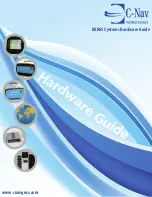
C-Nav Hardware Reference Guide
9
Ephemeris error
occurs when the broadcast GNSS message for the satellite’s orbital location
is inaccurate. It is typical that the radial component of this error is the smallest; the along-track
and cross-track errors are larger by an order of magnitude. The ‘line of sight’ projections of the
GNSS satellite positioning error affect each GNSS observation differently. Ephemeris errors
reflect a position prediction and tend to grow with time from the last GNSS Ground Control
Segment station upload.
Satellite Clocks
are fundamental to the GNSS system so that the one-way ranging
measurement process can be accomplished. Each satellite broadcasts it’s own clock
adjustment values to allow the user to develop accurate GNSS satellite clock predictability
models. These satellite clock errors affect both the C/A and P-code users in the same way,
which result in a residual clock error for each GNSS satellite. All GNSS observers receive an
identical satellite clock error.
Ionospheric errors
or delays are unique to the local area for each GNSS observer, and are
introduced due to free electrons in the ionosphere. The modulation on the signal is delayed in
proportion to the number of free electrons encountered. The ionosphere is usually reasonably
well behaved and stable in the temperate zones; however, near the equator or magnetic poles it
can fluctuate considerably. This local error can be resolved by the use of dual frequency, L1 and
L2, observations by the GNSS observer.
Survey-quality receivers will correct the raw pseudorange for the ionospheric delay. The
simplest correction employs an internal diurnal model of these delays. For Single Frequency (L1
only) GNSS users, the parameters can be updated using information in the GNSS correction
'communications message'. The effective accuracy of this modeling is about 2-5 meters in
ranging for users in the temperate zones.
A second technique for dual-frequency P-code receivers is to measure the signal at both
frequencies and directly solve for the delay. The difference between L1 and L2 arrival times
allows a direct solution. This dual-frequency technique typically provides 1 meter or better in
ranging accuracy, due to the ionosphere, for a well-calibrated receiver.
A third technique relies on a real-time ionospheric model providing corrections with accuracy of
1-2 meters or better in temperate zones.
Note: The solar 11-year activity cycle also affects the ionosphere and causes 'scintillation'
effects, which are problematical along the geo-magnetic equator when the solar cycle is at its
peak.
Tropospheric errors
are deviations in the velocity of the GNSS signal as it passes through the
troposphere, and are unique to the local area for each GNSS observer. Variations in
temperature, pressure, and humidity all contribute to variations in the speed of radio waves.
Both the code and carrier will show the same delays, and use of a reliable model can reduce
most of this error. For most users and circumstances, a simple model should be effectively
accurate to about 1 meter or better.
Multipath Errors
are caused by reflected signals entering the antenna of the GNSS receiver
and masking the real correlation peak. These effects tend to be more pronounced in a static
Содержание 1000
Страница 1: ...DGNSS Systems Hardware Guide www cnavgnss com ...
Страница 20: ...C Nav Hardware Reference Guide 20 Figure 2 3 C Nav Antenna Mounting Pole Dimensions ...
Страница 61: ...C Nav Hardware Reference Guide 61 Figure 3 61 C NaviGator II rev A front USB port model Outline Diagram mm ...
Страница 65: ...C Nav Hardware Reference Guide 65 Model No 3402 17 0070 Specifications ...
Страница 67: ...C Nav Hardware Reference Guide 67 Huber Suhner Lightning Protector Mounting Instructions ...
Страница 68: ...C Nav Hardware Reference Guide 68 ...
Страница 69: ...C Nav Hardware Reference Guide 69 MOXA Converters TCC 80I TCC 80I Specifications ...
Страница 70: ...C Nav Hardware Reference Guide 70 TCC 80I Dimensions Figure 4 3 Moxa TCC 80I Converter Dimensions TCC 82 ...
Страница 72: ...C Nav Hardware Reference Guide 72 Times Microwave LMR400 Coaxial Cable LMR400 Specifications ...
Страница 74: ...C Nav Hardware Reference Guide 74 ...










































